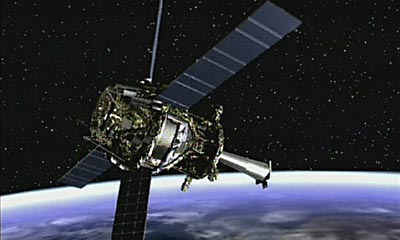|
|
 The concept behind Gravity Probe-B dates back more than 40 years, but the technology required to build it delayed its launch until now. s(credit: NASA) |
Levity and gravity: behind the story of Gravity Probe-B
by Dwayne A. Day
Monday, April 19, 2004
Just about every space scientist will agree that Gravity Probe-B is a survivor. Scheduled for launch from Vandenberg Air Force Base on Monday atop a Delta 2 rocket, it will orbit 400 miles over the Earth’s poles and test Einstein’s General Theory of Relativity. However, it already has cost $700 million—$300 million more than originally estimated and nearly as much as both of NASA’s Mars rovers combined—and is four years late. The stubborn little spacecraft has survived numerous hardware setbacks and delays and congressional scrutiny that should have killed it years ago. One astronomer on a different NASA space science program—who for obvious reasons wishes to remain anonymous—has joked that the Stanford University scientists who built the probe’s instruments either have amazing political skills, or are somehow blackmailing members of Congress, because they have miraculously survived significant problems and cost overruns.
Dr. Robert Cannon tells the story of Gravity Probe-B’s origins over four decades ago. Cannon was a guidance and control expert, a wizard with gyroscopes and related systems for guiding submarines, planes and missiles with precision over long distances. He had worked on such systems for North American Aviation, among other places, before becoming a professor at Stanford University in the late 1950s.
According to Cannon, one day in 1959 William Fairbank, an expert in low-temperature physics, invited him to have lunch at Stanford’s original men’s swimming pool, where the rule was that nobody wore swimsuits. There he met Leonard Schiff, the physics department chairman and an expert on Einstein’s General Theory of Relativity.
After swimming laps, the three naked men sat in a row along the side of the pool with their feet in the water while Schiff described what he called a “gedanken experiment” (or thought experiment). He proposed that in principle, a gyroscope could prove in a new way the General Theory of Relativity, which posits that space and time are distorted around a massive gravity source, a phenomenon known as “frame dragging.” It would require a gyro drift rate of less than one degree per million years. Cannon and Fairbank wondered whether there might be a way to actually do the experiment. Schiff asked Cannon what the best gyroscope ever made had achieved and Cannon said that would be the gyros used in submarine navigation systems, which had drift rates of about one degree per year, nowhere near the required precision. “Well, that’s why it’s just a gedanken experiment,” Schiff conceded, in apparent defeat.
The three men sat there for awhile thinking and finally Cannon suggested that if the experiment was done in orbit, then the primary cause of gyroscopic drift—gravity—could be reduced by a million. Fairbank noted that by working at temperatures of one degree above absolute zero, having a near-perfect sphere spinning in a near-zero atmosphere and a near-zero magnetic field would essentially eliminate other drift sources.
| The problem was that in 1959 all of the instruments needed for conducting the experiment were almost impossible to build. |
This is how the Gravity Probe-B experiment was born—with three nude men dangling their feet in a swimming pool pondering Einsteinian physics and spacecraft. In 1960 Schiff wrote up a more formal proposal of the idea, and he and Cannon pitched it for the next several decades. Gravity Probe-A, which was launched on a suborbital rocket in 1976, carried a precise clock to test one part of Einstein’s theory, but could not prove the rest.
The problem was that in 1959 all of these instruments for conducting the experiment were almost impossible to build. Small, highly precise gyroscopes and a container that could bring temperatures down to near absolute zero required technological leaps that took decades. It was not until 1995, over the protests of many scientists, that NASA finally developed a formal design for the spacecraft and a plan to launch it by 2000. The satellite would use a telescope to precisely focus on the star IM Pegasus. Four small gyroscopes attached to the telescope would spin in a vacuum and any changes in their spin rate would be precisely measured by highly sensitive magnetometers known as SQUIDS.
But in 1999 the project experienced major development problems when the large thermos bottle, called a dewar, which holds the supercold helium surrounding the instruments, did not cool down as quickly as expected. It had to be redesigned. Testing the instruments also raised problems as well. The launch was delayed again because of a booster rocket problem. The spacecraft was scheduled for launch in December 2003 when a problem with a control unit for the experiment package caused yet another delay.
Even if Gravity Probe-B does make it into orbit and works as advertised, a negative result could present more problems than a positive one. As a review group warned in 1995, if the spacecraft does not exhibit the effects predicted by Einstein’s theory, scientists would want to fly a second spacecraft to check the results. But nobody will want to pay for it, and Stanford has regrettably rescinded the no swimming trunks rule.
Dwayne A. Day is a Washington, DC based space policy analyst.
|
|
